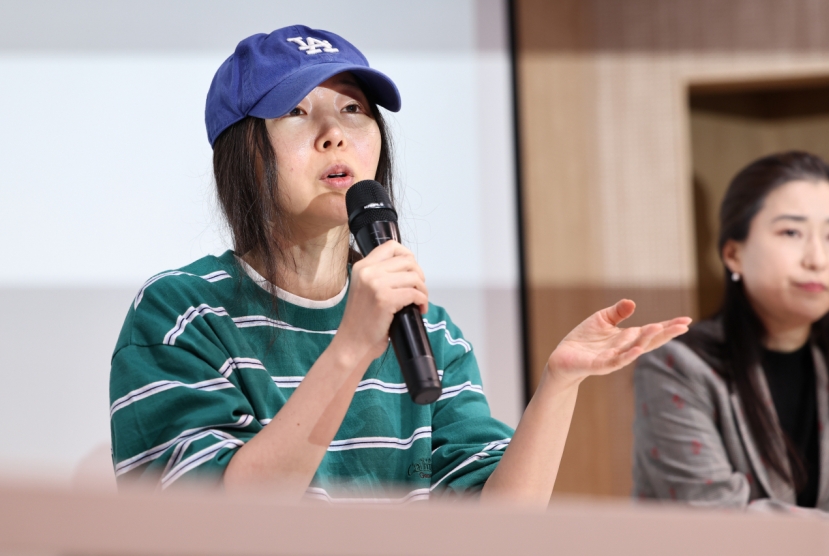Installation artist weaves together strands of disconnected lives
By KH디지털2Published : March 23, 2016 - 13:56
A strand of threads have always been the fountain of inspiration for installation artist Lee Eun-sook. For the 59-year-old, a thread is a vital means to restore and connect severed relations, not just of war-torn families but also of estranged family members.
Through her recent exhibition, "Thread and Light -- The Beginning of Relationship," she tries to shed a light on modern-day division and disconnection, and to instill a ray of hope for restoration.
"There are many discords and a sense of separation in our society, not to mention at home, and I would like to focus on 'you and me' and how we need to sit down and talk to each other face to face," Lee said during an interview with Yonhap News Agency on Wednesday.
One of the few South Korean fiber artists, she has created an unique art world where she painfully hand-weaves neon-colored threads and various fabrics, and puts them onto polyester films, which in turn get reconstructed into various forms of eye-catching installation art. By conjuring up fantasy-like bright installations, glowing in dark light, she said she aims to console "all the distressed, victimized souls."
Since her close call with death in 1986, when almost 40 percent of her body was badly burned while preparing for her first exhibition, Lee's formed a deep sense of attachment to her artwork, she said.
"I thought to myself at that time, 'My two children can grow whatever happens to me, but my art will perish with me,'" she said. "Since then, I've willed myself to devote my whole life to art."
In 2007, the light and textile artist received international attention for her monumental, illuminating installation "Vanished Berlin Wall" in front of the Brandenburg Gate in Berlin, which reflected the painful Korean situation as the last vestige of the Cold War. She used archived photos and some 5,000 names of Koreans who were separated from their families during the 1950-1953 Korean War in building the transparent polyester walls.
It was only natural for Lee to feel deeply attached to the theme.
Her parents escaped war-torn North Korea and met each other in a refugee camp on South Korea's southern island of Geoje. Having left a wife and four children behind in the North, her father lived a life full of remorse and despair in the South. Her mother met her brother through the government-sponsored reunions of separated families, but her father wasn't lucky enough to have a chance to be reunited. He passed away a few years ago.
In tribute to her late father, she installed illuminating art in February 2013 that was shaped like Korean letters symbolizing the names of her stepsiblings. The exhibition took place at Imjingak, a park some 7 km from the Military Demarcation Line, which is the northernmost point that South Koreans are allowed to go. During the exhibition, some South Koreans in their 70s and 80s visited the park, calling out the names of their loved ones over the barbed wire.
Last year, she performed yet another interesting project in Berlin, in time for the 70th anniversary of Liberation Day, celebrating the end of Japanese colonial rule over the Korean Peninsula (1910-1945). Strapping two spools of neon threads -- one yellow-green and the other orange -- on her back, she unraveled the reels onto the pavement as she walked the around 3.8 kilometers between the embassies of the two Koreas. When she arrived at the North Korean Embassy, she cut the threads to express a deep yearning for reunification.
Her longing for connection stems, in part, from her own bitter family affairs: She separated from her husband in early 2000, and she's also severed ties with her own siblings and mother in the South, due to some legal battles over inheritance.
"I want to comfort people, with my artwork, who went through traumatic and heartbreaking events in their lives," she said.
The exhibition runs at the Blume Museum of Contemporary Art in Paju, a northern suburb of Seoul, from March 12 to June 19. (Yonhap)



![[Herald Interview] 'Amid aging population, Korea to invite more young professionals from overseas'](http://res.heraldm.com/phpwas/restmb_idxmake.php?idx=644&simg=/content/image/2024/04/24/20240424050844_0.jpg&u=20240424200058)















